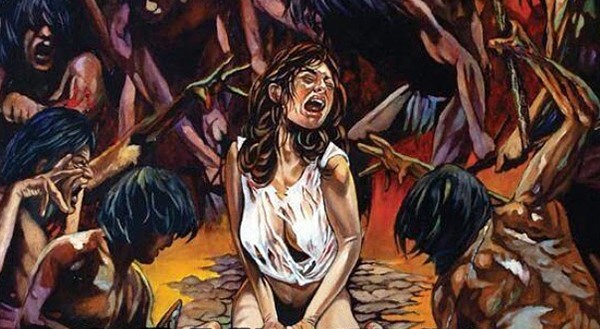Hi-Lo Joe, 2017.
Written and Directed by James Kermack.
Starring Matthew Stathers, Lizzie Philips, Tom Bateman, Gethin Anthony, and Joe Dixon.
SYNOPSIS:
Everyone loves Joe Ridley, except Joe. Dark, crushing depression envelops him and a childhood trauma haunts him. Elly loves him but he is pushing her away. Can he save himself before he loses everything?
For a fleeting moment, I thought of making the review simply a list of all the ways this film went wrong. I thought of adding timestamps to each dreadful moment, essentially giving a play-by-play of this train wreck of a movie. However, after quickly realising that such a task would take me weeks, not to mention that I’d probably get into trouble for spoiling the movie – if telling you what happens in this dumpster fire counts as spoiling it – I decided against it. So instead, I’ve decided to do my job properly and neatly summarise what’s wrong with Hi-Lo Joe in a succinct 1000 words. Buckle your seatbelts though, because you’re in for a bumpy ride.
After a brief introduction to the eponymous Joe (Matthew Stathers), the film lands the audience directly in the middle of a party at a bar below Joe’s house. I say it lands the audience in the party because the whole scene is near enough shot in a Peep Show-esque POV. Here we meet Joe and his love interest Elly (Lizzie Philips), and instantly there are problems. Both actors seem completely oblivious to the fact that they are in a film and that there is a camera right in front of them. Instead, they think they’re on stage; projecting their voices to the back of the room and waving their arms about for even those sat in the gods to see. At first I thought this was because they were drunk and at a noisy party, but it soon turned out that this was just the way they were going to act for the rest of the film.
Unlike the loud voices and generally god-awful over acting, which stay throughout the entire film, the POV shots cease almost immediately after the party, and are replaced by standard, rule-of-thirds obeying shots. This doesn’t seem like too much of a problem at first – the party was chaotic and using POV is a nice way of placing an audience in chaos, I guess – but it quickly becomes one. A few scenes later, the POV returns, for no rhyme or reason, before disappearing again, this time in the middle of a conversation. At one moment we’re looking at Joe head on, the next we’re seeing him from an angle for no reason whatsoever. The conversation doesn’t change to pull us away from Joe, nor is there any other such atmospheric alteration that would warrant a change in style. Rather, the style changes simply because… the director (James Kermack) wanted more shot variety? I don’t know. Whatever the reason, the effect is an inconsistent style that throws the audience.

By about a third in, I realised exactly what was wrong with the movie. It wasn’t supposed to be a movie at all. It was meant to be a play. It certainly feels more like a play than it does a movie. Aside from the overacting and the clear lack of coherent visual style, the film also reveals almost all the important details through speech. There are a few times where the director chooses to use visual element to carry the plot, but all efforts are seriously uninspired and clichéd (Joe’s apartment walls crumbling to convey his declining mental state being a particularly on the nose example).
With this in mind, I suppose it’s right to ask: Would Hi-Lo Joe have made a good play? And the answer to this is: No. Technical and stylistic issues aside, the story is simply uninteresting. Joe is unlikable, which isn’t necessarily a bad thing, but his problems seem so insignificant that even if he was likeable it’s unlikely that any audience would care. Depression is a serious mental illness and can utterly devastate people’s lives, but it isn’t until about halfway through the film that we even get the sense that Joe really is depressed at all. Up until that point, all we see is Joe having a couple of bad dreams. He goes to work, cracks jokes, throws parties, and generally has a good time. There is no sense of him spiralling down. Instead, he just hits rock bottom about halfway in.
I imagine the director’s defence in light of this criticism is that such a portrayal mirrors real life. We often don’t see people with depression as depressed until they do something drastic, and that by neglecting to show Joe’s gradual decline, the audience gets put in the shoes of someone looking from the outside in. This may be true, but it makes the film neither interesting nor clever. Without so much as an inciting incident, the audience is left watching the film on the good will that something will indeed happen, not because it is foreshadowed in any meaningful or artistic way, but because it says so in the synopsis. Furthermore, Joe is so unlikeable and his problems so minuscule that the audience are drawn into thinking, why doesn’t he just get over it? A serious problem for a film that attempts to raise awareness for mental health issues.
Above everything else, what really makes this film so unbearable to watch is that it masquerades as a movie that has something to say, when it simply doesn’t. It holds its important and delicate subject matter in one clumsy hand while using the other to smear its pseudo-philosophical bullshit over its own crumbling walls.
Flickering Myth Rating – Film: ★ / Movie: ★
James Turner is a writer and musician based in Sheffield. You can follow him on Twitter @JTAuthor













